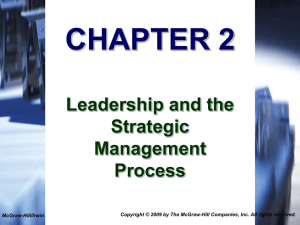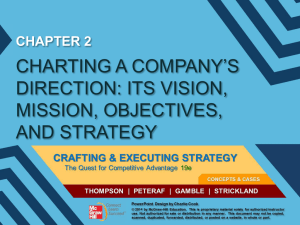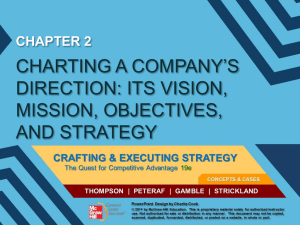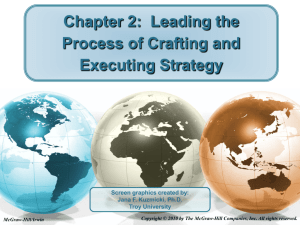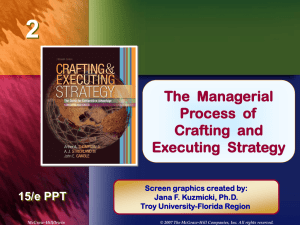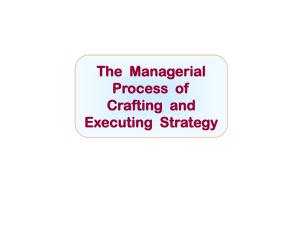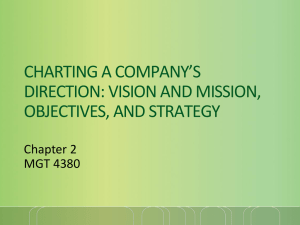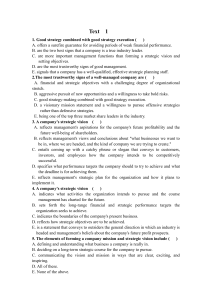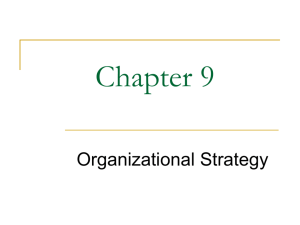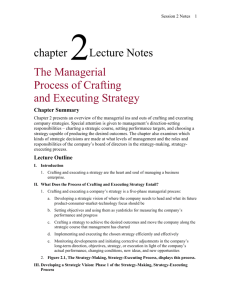strategic vision
advertisement
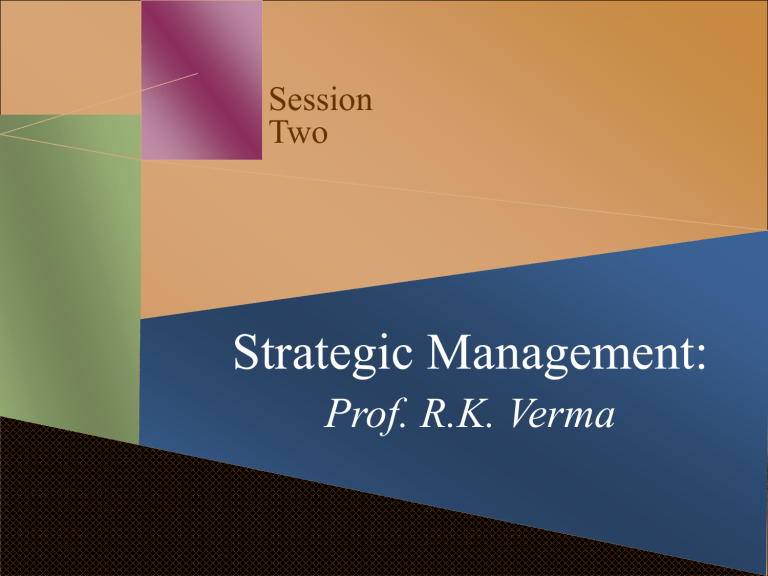
Session Two Strategic Management: Prof. R.K. Verma MODULE DESCRIPTOR Topic Concepts of Strategy: Environmental Analysis and Diagnosis: Strategy Formulation and Choice of alternatives: Coverage Defining strategy, levels at which strategy operates; Approaches to strategic decision making; and purpose, objectives and goals Concept of environment, components of environment (Economic, legal, social, political and technological). Environmental scanning techniques- SWOT (TOWS). Porter’s Five forces model of competition in an Industry Corporate level strategies— Stability, Expansion, Retrenchment Combination strategies. BCG matrix Business level strategies— Generic business strategies Cost leadership business strategy Porter’s Generic Business strategies APPROACHES TO STRATEGIC DECISION MAKING; AND PURPOSE, OBJECTIVES AND GOALS by: Prof. R.K. Verma, Dean, School of Business Studies “UNLESS WE CHANGE OUR DIRECTION, WE ARE LIKELY TO END UP WHERE WE ARE HEADED.” Chinese Proverb “Management’s job is not to see the company as it is . . . but as it can become.” John W. Teets ROADMAP What Does the Process of Crafting and Executing Strategy Entail? Developing a Strategic Vision: Phase 1 of the StrategyMaking, Strategy-Executing Process Setting Objectives: Phase 2 of the Strategy-Making, StrategyExecuting Process Crafting a Strategy: Phase 3 of the Strategy-Making, Strategy-Executing Process Implementing and Executing the Strategy: Phase 4 of the Strategy-Making, Strategy-Executing Process Initiating Corrective Adjustments: Phase 5 of the StrategyMaking, Strategy-Executing Process Corporate Governance: The Role of the Board of Directors in the Strategy-Making, Strategy-Executing Process THE STRATEGY-MAKING, STRATEGYEXECUTING PROCESS: HEART &SOUL DEVELOPING A STRATEGIC VISION Phase 1 of the Strategy-Making Process Involves thinking strategically about Future direction of company Changes in company’s product-marketcustomer-technology to improve Current market position Future prospects A strategic vision is a road map showing the route a company intends to take in developing and strengthening its business. It paints a picture of a company’s destination and provides a rationale for going there. VISION Kotter (1990) defines it as a "description of something (an organization, a corporate culture, a business, a technology, an activity) in the future". El-Namaki (1992) considers it as a "mental perception of the kind of environment an individual, or an organization, aspires to create within a broad time horizon and the underlying conditions for the actualization of this perception". Miller and Dess (1996) view it simply as the "category of intentions that are broad, all-inclusive, and forward thinking". J. Kotter, A Force for Change: How Leadership Differs from Management (London: Free Press, 1990); M. S. S. El-Namaki, "Creating a corporate vision" Long Range Planning, Vol. 25, No. 6, (1992), pp. 25 – 29; A. Miller and G. G. Dess, Strategic Management (2nd. ed.) (New York: McGraw-Hill, 1996), p. 6. (c) Dr. Azhar Kazmi 2008 8 KEY ELEMENTS VISION OF A STRATEGIC Delineates management’s aspirations for the business – Charts a strategic path for the future “Where are we going?” Steers energies of employees in a common direction Molds organizational identity Is distinctive and specific to a particular organization Avoids use of generic language Triggers strong emotions Is challenging, uncomfortable, nail biting Infosys Our Vision, Mission and Values Vision "We will be a globally respected corporation." Mission "Strategic Partnerships for Building Tomorrow’s Enterprise." Values We believe that the softest pillow is a clear conscience. The values that drive us underscore our commitment to: CLIFE Client Value: To surpass client expectations consistently Leadership by Example: To set standards in our business and transactions and be an exemplar for the industry and ourselves Integrity and Transparency: To be ethical, sincere and open in all our transactions Fairness: To be objective and transaction-oriented, and thereby earn trust and respect Excellence: To strive relentlessly, constantly improve ourselves, our teams, our services and products to become the best EXELON’S STRATEGIC VISION One Company, One Vision. Exelon strives to build exceptional value - by becoming the best and most consistently profitable electricity and gas company in the United States. To succeed, we must . . . Live up to our commitments . . . Perform at world-class levels . . . Invest in our consolidating industry . . . EXAMPLES OF STRATEGIC VISIONS Red Hat Linux To extend our position as the most trusted Linux and open source provider to the enterprise. We intend to grow the market for Linux through a complete range of enterprise Red Hat Linux software, a powerful Internet management platform, and associated support and services. Wells Fargo We want to satisfy all of our customers’ financial needs, help them success financially, be the premier provider of financial services in every one of our markets, and be known as one of America’s great companies. EXAMPLES OF STRATEGIC VISIONS Wyeth Our vision is to lead the way to a healthier world. By carrying out this vision at every level of our organization, we will be recognized by our employees, customers, and shareholders as the best pharmaceutical company in the world, resulting in value for all. We will achieve this by: Leading the world in innovation by linking pharmaceutical, biotech, and vaccines technologies Making quality, integrity, and excellence hallmarks of the way we do business Attracting, developing, and motivating the best people Continually growing improving our business EXAMPLES OF STRATEGIC VISIONS Dental Products Division of 3M Corporation Become THE supplier of choice to the global dental professional markets, providing world-class quality and innovative products. [All employees of the division wear badges bearing these words, and whenever a new product or business procedure is being considered, management asks “Is this representative of THE leading dental company?”] Nike To bring innovation inspiration to every athlete in the world. EXAMPLES OF STRATEGIC VISIONS Intel Our vision: Getting to a billion connected computers worldwide, millions of servers, and trillions of dollars of e-commerce. Intel’s core mission is being the building block supplier to the Internet economy and spurring efforts to make the Internet more useful. Being connected is now at the center of people’s computing experience. We are helping to expand the capabilities of the PC platform and the Internet . . . We have seen only the early stages of deployment of digital technologies. EXAMPLES OF STRATEGIC VISIONS Heinz Our vision, quite simply, is to be the world’s premier food company, offering nutritious, superior tasting foods to people everywhere. Being the premier food company does not mean being the biggest but it does mean being the best in terms of consumer value, customer service, employee talent, and consistent and predictable growth. General Electric We will become number one or number two in every market we serve, and revolutionize this company to have the speed and agility of a small enterprise. CHARACTERISTICS STATEMENT MISSION Defines current business activities, highlighting boundaries of current business OF A Present products and services Types of customers served Conveys Who we are, What we do, and Why we are here A company’s mission is not to make a profit! Its true mission is its answer to “What will we do to make a profit?” Making is profit is an objective or intended outcome! MISSION Thompson (1997) defines mission as the "essential purpose of the organization, concerning particularly why it is in existence, the nature of the business(es) it is in, and the customers it seeks to serve and satisfy". Hunger and Wheelen (1999) say that mission is the "purpose or reason for the organization's existence". J. L. Thompson: Strategic Management: Awareness and Change, (3rd ed.) (London: International Thomson Business Press) 1997, p.6; J. D. Hunger & T. L. Wheelen: Strategic Management, (Reading, Mass.: Addison Wesley Longman), 1999, p. 10. (c) Dr. Azhar Kazmi 2008 23 STRATEGIC VISION A strategic vision concerns a firm’s future business path - “where we are going” Markets to be pursued Future technologyproduct-customer focus Kind of company management is trying to create VS. MISSION The mission statement of most companies focuses on current business activities “who we are and what we do” Current product and service offerings Customer needs being served Technological and business capabilities CHARACTERISTICS OF MISSION STATEMENTS It should be feasible It should be precise It should be clear It should be motivating It should be distinctive It should include major components of strategy It should indicate how objectives are to be accomplished (c) Dr. Azhar Kazmi 2008 25 Strategic Positioning 1. Vision 2. Culture 3. Capability 4. Environment Strategic Choices 1. Corporate Level 2. Business Level 3. Innovation 4. Evaluation Strategic Choices 1.Orgnising 2. Processes 2. Resourcing 3. Evaluation 4. Practice 5. Changing KEY ELEMENTS STATEMENT OF A MISSION Three factors to consider Customer needs – What is being satisfied Customer groups – Who is being satisfied Technologies/resources/business approaches used and activities performed – How customer needs are satisfied TRADER JOE’S MISSION STATEMENT (a unique grocery store chain) To give our customers the best food and beverage values that they can find anywhere and to provide them with the information required for informed buying decisions. We provide these with a dedication to the highest quality of customer satisfaction delivered with a sense of warmth, friendliness, fun, individual pride, and company spirit. LINKING THE VISION WITH COMPANY VALUES A statement of values is often provided to guide the company’s pursuit of its vision Values – Beliefs, business principles, and ways of doing things that are incorporated into Company’s operations Behavior of workforce Values statements Contain between four and eight values Are ideally tightly connected to and reinforce company’s vision, strategy, and operating practices EXAMPLE: COMPANY VALUES Home Depot Creating shareholder value Entrepreneurial spirit Building strong relationships Excellent customer service Giving back to the community Taking care of people Respect for all people Doing the right thing EXAMPLE: COMPANY VALUES Du Pont Safety Ethics Respect for people Environmental stewardship COMMUNICATING THE STRATEGIC VISION An exciting, inspirational vision Contains memorable language Clearly maps company’s future direction Challenges and motivates workforce Provokes emotion and enthusiasm Winning support for the vision involves Putting “where we are going and why” in writing Distributing the statement organization-wide Having executives explain the vision to the workforce EXAMPLES: VISION SLOGANS Levi Strauss & Company “We will clothe the world by marketing the most appealing and widely worn casual clothing in the world.” Microsoft Corporation “Empower people through great software—any time, any place, and on any device.” Mayo Clinic “The best care to every patient every day.” EXAMPLES: VISION SLOGANS Scotland Yard “To make London the safest major city in the world.” Greenpeace “To halt environmental abuse and promote environmental solutions.” Charles Schwab “To provide customers with the most useful and ethical financial services in the world.” OVERCOMING RESISTANCE VISION TO A NEW STRATEGIC Mobilizing support for a new vision entails Reiterating basis for the new direction Addressing employee concerns head-on Calming fears Lifting spirits Providing updates and progress reports as events unfold STRATEGIC INFLECTION POINTS There are times when companies come to a major fork in the road. Perhaps because market conditions are changing rapidly in ways that threaten or endanger the company’s business prospects Perhaps because the strategy simply runs out of stream Perhaps because the actions of competitors block the success of the company’s present strategic course and strategy Critical decisions have to be made about where do we go from here A major new directional path may have to be taken A major new strategy may be needed INTEL’S “STRATEGIC INFLECTION POINTS” Prior to mid-1980s Focus on memory chips Starting in mid-1980s Abandon memory chip business (due to lower-cost Japanese companies taking over the market) and Become preeminent supplier of microprocessors to PC industry Make PC central appliance in workplace and home Be undisputed leader in driving PC technology forward 1998 Shift focus from PC technology to becoming the preeminent building block supplier to the Internet economy PAYOFFS OF A CLEAR STRATEGIC VISION Crystallizes an organization’s long-term direction Reduces risk of rudderless decision-making Assists in gaining support of organizational members for changes to make the vision a reality Helps keep strategy-related actions of managers on common path Helps an organization prepare for the future SETTING OBJECTIVES Phase 2 of the Strategy-Making Process Purpose of setting objectives Converts vision into specific performance targets Creates yardsticks to track performance Pushes firm to be inventive, intentional, and focused in its actions Setting challenging, achievable objectives guards against Complacency Internal confusion Status quo performance CHARACTERISTICS OF OBJECTIVES Represent commitment to achieve specific performance targets Spell-out how much of what kind of performance by when Well-stated objectives are Quantifiable Measurable Contain a deadline for achievement Establishing objectives converts the vision into concrete performance outcomes! TYPES OF OBJECTIVES REQUIRED Financial Objectives Outcomes focused on improving financial performance $ Strategic Objectives Outcomes focused on improving long-term competitive business position EXAMPLES: FINANCIAL OBJECTIVES X % increase in annual revenues X % increase annually in after-tax profits X % increase annually in earnings per share Annual dividend increases of X % Profit margins of X % X % return on capital employed (ROCE) Increased shareholder value Strong bond and credit ratings Sufficient internal cash flows to fund 100% of new capital investment Stable earnings during periods of recession EXAMPLES: STRATEGIC OBJECTIVES Winning an X % market share Achieving lower overall costs than rivals Overtaking key competitors on product performance or quality or customer service Deriving X % of revenues from sale of new products introduced in past 5 years Achieving technological leadership Having better product selection than rivals Strengthening company’s brand name appeal Having stronger national or global sales and distribution capabilities than rivals Consistently getting new or improved products to market ahead of rivals UNILVER’S STRATEGIC OBJECTIVES AND FINANCIAL Grow annual revenues by 5-6% annually Increase operating profit margins from 11% to 16% within 5 years Trim company’s 1200 food, household, and personal care products down to 400 core brands Focus sales and marketing efforts on those brands with potential to become respected, market-leading global brands Streamline company’s supply chain THE KROGER COMPANY’S STRATEGIC AND FINANCIAL OBJECTIVES Reduce our operating and administrative cost by $500 million by year-end 2003 Leverage our $51 billion size to achieve greater economies of scale Reinvest in our core business to increase sales and market share Grow earnings per share by 10-12% in 2002-2003 and by 13-15% annually starting in 2004. SEAGATE TECHNOLOGY’S STRATEGIC OBJECTIVES Solidify the company’s No. 1 position in the overall market for hard-disk drives Get more Seagate drives into popular consumer electronics products (i.e. video recorders) Take share away from Western Digital in providing disk drives for Microsoft’s Xbox Capture a 10% share of the market for 2.5-inch hard drives for notebook computers by 2004 HEINZ’S FINANCIAL AND STRATEGIC OBJECTIVES Achieve earnings per share in the range of $2.15-$2.25 in 2004 Increase operating cash flow by 45% to $750 million Reduce net debt by $1.3 billion in 2003 and further strengthen the company balance sheet in 2004 Continue to introduce new and improved food products Remove the clutter in the company product offerings by reducing the number of SKUs Increase spending on trade promotion and advertising by $200 million to strengthen the recognition and market shares of the company’s core brands Divest non-core underperforming product lines DUPONT’S FINANCIAL AND STRATEGIC OBJECTIVES To achieve annual revenue growth of 5 to 6% and annual earnings-per-share growth averaging 10% Grow per-share profits faster than revenues by (a) (b) (c) Increasing productivity, Selling enough new products each year that average prices and average margins rise, and Using surplus cash to buy back shares Sell the company’s low-margin textiles and interiors division (with sales of $6.6 billion and operating profits of only $114 million) 3M CORPORATION’S FINANCIAL AND STRATEGIC OBJECTIVES To achieve annual growth in earnings per share of 10% or better, on average A return on stockholders’ equity of 20-25% A return on capital employed of 27% or better Have at least 30% of sales come from products introduced in the past four years STRATEGIC PERFORMANCE FOSTERS BETTER FINANCIAL PERFORMANCE A company’s achievement of satisfactory financial performance, by itself, is not enough Financial performance measures are “lagging indicators” reflecting results of past decisions and actions Of equal or greater importance is a company’s performance on measures of its strategic well-being — its competitiveness and market position Strategic performance measures are “leading indicators” of a company’s future financial performance and business prospects Achievement of strategic performance targets Signals growing competitiveness Signals growing strength in the marketplace BALANCED SCORECARD APPROACH – STRATEGIC AND FINANCIAL OBJECTIVES Balanced scorecard approach for measuring company performance requires both – Financial objectives Strategic objectives Emphasis on financial performance may assume priority over strategic performance when company’s Financial performance is dismal and Survival is threatened Otherwise, management is advised to put The surest path to sustained future profitability more achievingpursue strategic yearemphasis after year is on to relentlessly strategic outcomes objectives that strengthen a company’s business position and give it a growing competitive advantage over rivals! SHORT-TERM VS. LONG-TERM OBJECTIVES Short-term objectives Targets to be achieved soon Milestones or stair steps for reaching long-range performance Long-term objectives Targets to be achieved within 3 to 5 years Prompt actions now that will permit reaching targeted long-range performance later CONCEPT OF STRATEGIC INTENT A company exhibits strategic intent when it relentlessly pursues an ambitious strategic objective and concentrates its competitive actions and energies on achieving that objective! CHARACTERISTICS OF STRATEGIC INTENT Indicates firm’s intent to making quantam gains in competing against key rivals and to establishing itself as a winner in the marketplace, often against long odds Involves establishing a grandiose performance target that is out of proportion to its immediate capabilities and market position but then devoting the company’s full resources and energies to achieving the target over time Signals relentless commitment to achieving a particular market position and competitive standing OBJECTIVES ARE NEEDED AT ALL LEVELS 1. First, establish organization-wide objectives and performance targets 2. Next, set business and product line objectives 3. Then, establish functional and departmental objectives 4. Individual objectives are established last IMPORTANCE OF TOP-DOWN OBJECTIVES Guide objective-setting and strategy-making at lower levels Ensures financial and strategic performance targets for all business units, divisions, and departments are directly connected to achieving company-wide objectives Integration of objectives has two advantages Helps produce cohesion among objectives and strategies of different parts of organization Helps unify internal efforts to move a company along the chosen strategic path CRAFTING A STRATEGY Phase 3 of the Strategy-Making Process Strategy-making involves entrepreneurship – searching for opportunities To do new things or To do existing things in new or better ways Strategizing involves Picking up on happenings in the external environment and Steering company activities in new directions dictated by shifting market conditions ACTIVITIES INVOLVED IN CRAFTING A STRATEGY Studying market trends and actions of competitors Listening to customers, anticipating their changing needs Scrutinizing business possibilities based on new technology Building firm’s market position via acquisitions or new products Pursuing ways to strengthen firm’s competitive capabilities Our strategy will be . . . WHO PARTICIPATES IN CRAFTING A COMPANY’S STRATEGY? Chief executive officer - CEO Senior corporate executives Chief financial officer - CFO Managers of business divisions and major product lines Key VPs for production, marketing, human resources, and other functional departments Every company manager has a strategy-making, strategy-executing role – ranging from minor to major – for the area he or she heads! STRATEGIZING: AN INDIVIDUAL OR TEAM RESPONSIBILITY? Teams are increasingly used because Finding market- and customer-driven solutions is necessary Complex strategic issues cut across functional areas and departmental units Ideas of people with different backgrounds and experiences strengthen strategizing effort Groups charged with crafting the strategy often include the people charged with implementing it A COMPANY’S STRATEGY-MAKING HIERARCHY LEVELS OF STRATEGY-MAKING IN A DIVERSIFIED COMPANY Corporate-Level Managers Corporate Strategy Two-Way Influence Business-Level Managers Functional Managers Business Strategies Two-Way Influence Functional Strategies Two-Way Influence Operating Managers Operating Strategies LEVELS OF STRATEGY-MAKING A SINGLE-BUSINESS COMPANY Business-Level Managers IN Business Strategy Two-Way Influence Functional Managers Functional Strategies Two-Way Influence Operating Managers Operating Strategies TASKS OF CORPORATE STRATEGY Moves to achieve diversification Actions to boost performance of individual businesses Capturing valuable cross-business synergies to provide 1 + 1 = 3 effects! Establishing investment priorities and steering corporate resources into the most attractive businesses TASKS OF BUSINESS STRATEGY Initiating approaches to produce successful performance in a specific business Crafting competitive moves to build sustainable competitive advantage Developing competitively valuable competencies and capabilities Uniting strategic activities of functional areas Gaining approval of business strategies by corporate-level officers and directors TASKS OF FUNCTIONAL STRATEGIES Game plan for a strategically-relevant function, activity, or business process Detail how key activities will be managed Provide support for business strategy Specify how functional objectives are to be achieved TASKS OF OPERATING STRATEGIES Concern narrower strategies for managing grassroots activities and strategically-relevant operating units Add detail to business and functional strategies Delegation of responsibility to frontline managers UNITING THE COMPANY’S STRATEGY-MAKING EFFORT A firm’s strategy is really a collection of initiatives undertaken by managers at all levels in the organizational hierarchy All the various strategic initiatives must be unified into a cohesive, company-wide action plan Pieces of strategy should fit together like the pieces of a puzzle WHAT IS A STRATEGIC PLAN? Its strategic vision and business mission A Company’s Strategic Plan Consists of Its strategic and financial objectives Its strategy IMPLEMENTING STRATEGY AND EXECUTING Phase 4 of the Strategy-Making Process Action-oriented, operations-driven activity aimed at shaping performance of core business activities in a strategysupportive manner Tougher and more time-consuming than crafting strategy Key tasks include Improving efficiency of the strategy being executed Showing measurable progress in achieving targeted results WHAT DOES STRATEGY IMPLEMENTATION INVOLVE? Building a capable organization Allocating resources to strategy-critical activities Establishing strategy-supportive policies Instituting best practices and programs for continuous improvement Installing information, communication, and operating systems Motivating people to pursue the target objectives Tying rewards to achievement of results Creating a strategy-supportive corporate culture Exerting the leadership necessary to drive the process forward and keep improving CHARACTERISTICS OF GOOD STRATEGY EXECUTION Involves creating strong “fits” between strategy and Organizational capabilities Reward structure Internal operating systems Organization’s work climate and culture The stronger the “fits” the Better the execution Higher a company’s odds of achieving its performance targets EVALUATING PERFORMANCE AND MAKING CORRECTIVE ADJUSTMENTS Phase 4 of the Strategy-Making Process Tasks of crafting and implementing the strategy are not a one-time exercise Customer needs and competitive conditions change New opportunities appear; technology advances; any number of other outside developments occur One or more aspects of executing the strategy may not be going well New managers with different ideas take over Organizational learning occurs All these trigger the need for corrective actions and adjustments on an as-needed basis MONITORING, EVALUATING, AND ADJUSTING AS NEEDED Taking actions to adjust to the march of events tends to result in one or more of the following Altering long-term direction and/or redefining the mission/vision Raising, lowering, or changing performance objectives Modifying the strategy Improving strategy execution CORPORATE GOVERNANCE: STRATEGIC ROLE OF A BOARD OF DIRECTORS Exercise strong oversight to ensure the five tasks of strategic management are executed to benefit Shareholders or Stakeholders Make sure executive actions are not only proper but also aligned with interests of stakeholders OBLIGATIONS OF A BOARD OF DIRECTORS Be inquiring critics and overseers Evaluate caliber of senior executives’ strategy-making and strategy-executing skills Institute a compensation plan for top executives rewarding them for results that serve interests of Stakeholders and Shareholders Have courage to intervene when things are not going well or to rein in a CEO who steps “out of bounds” GOOD CORPORATE GOVERNANCE MATTERS The whole fabric of effective corporate governance is undermined when boards of directors shirk their responsibility to maintain ultimate control over Company’s strategic direction, Major elements of its strategy, and Business approaches management is using to implement and execute the strategy Board members are obligated to rein in a CEO who oversteps the bounds of sound business principles and ethical behavior A rubber stamp board abdicates its Boards of directors have a very important oversight role in responsibility to shareholders the strategy-making, strategy-executing process! BUSINESS MODEL Business model could be defined as “a representation of a firm's underlying core logic and strategic choices for creating and capturing value within a value network.” Shafer, Scott M. & Smith, H. Jeff & Linder, Jane C., 2005. "The power of business models," Business Horizons, Elsevier, vol. 48(3), pages 199-207 (c) Dr. Azhar Kazmi 2008 85
